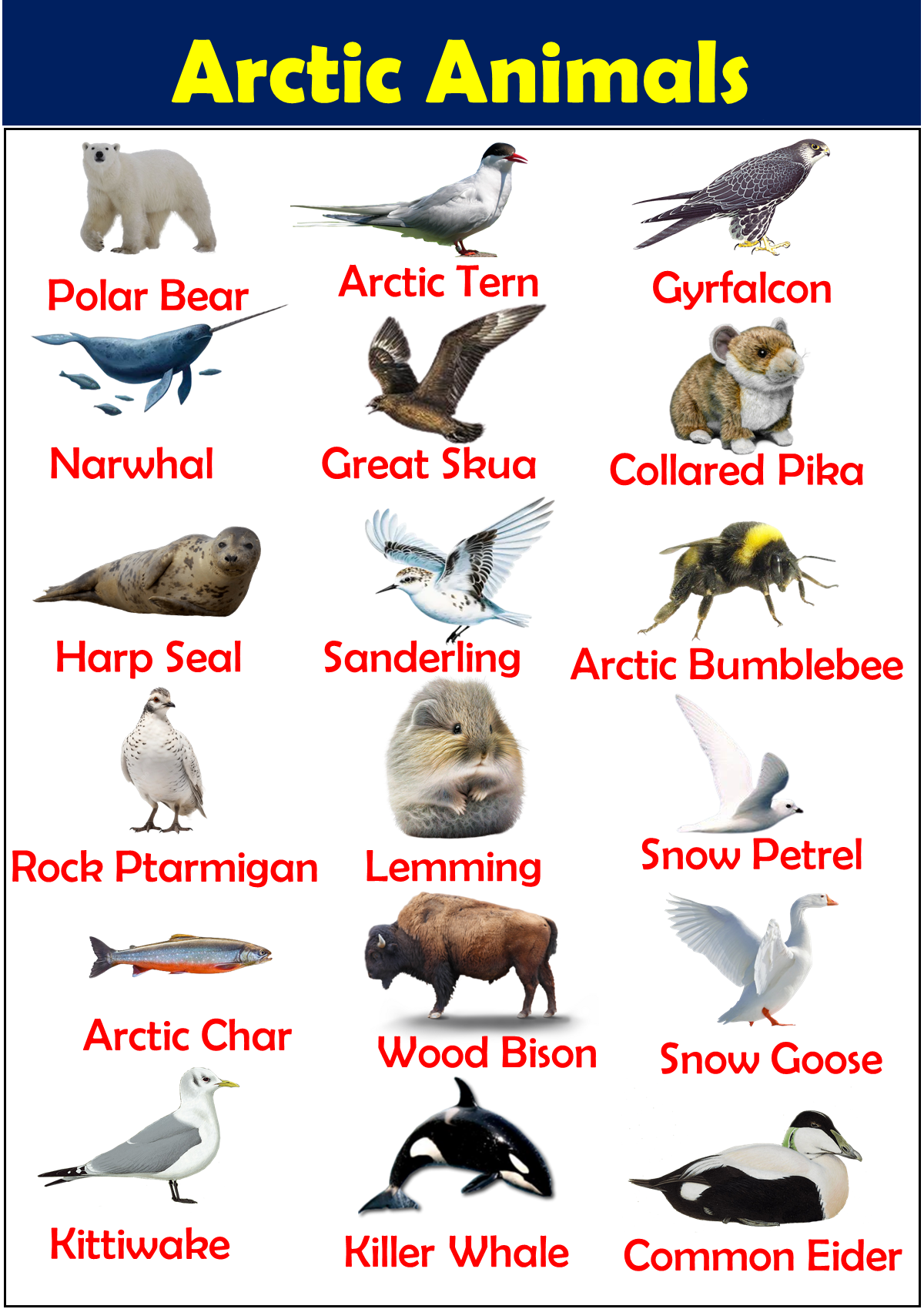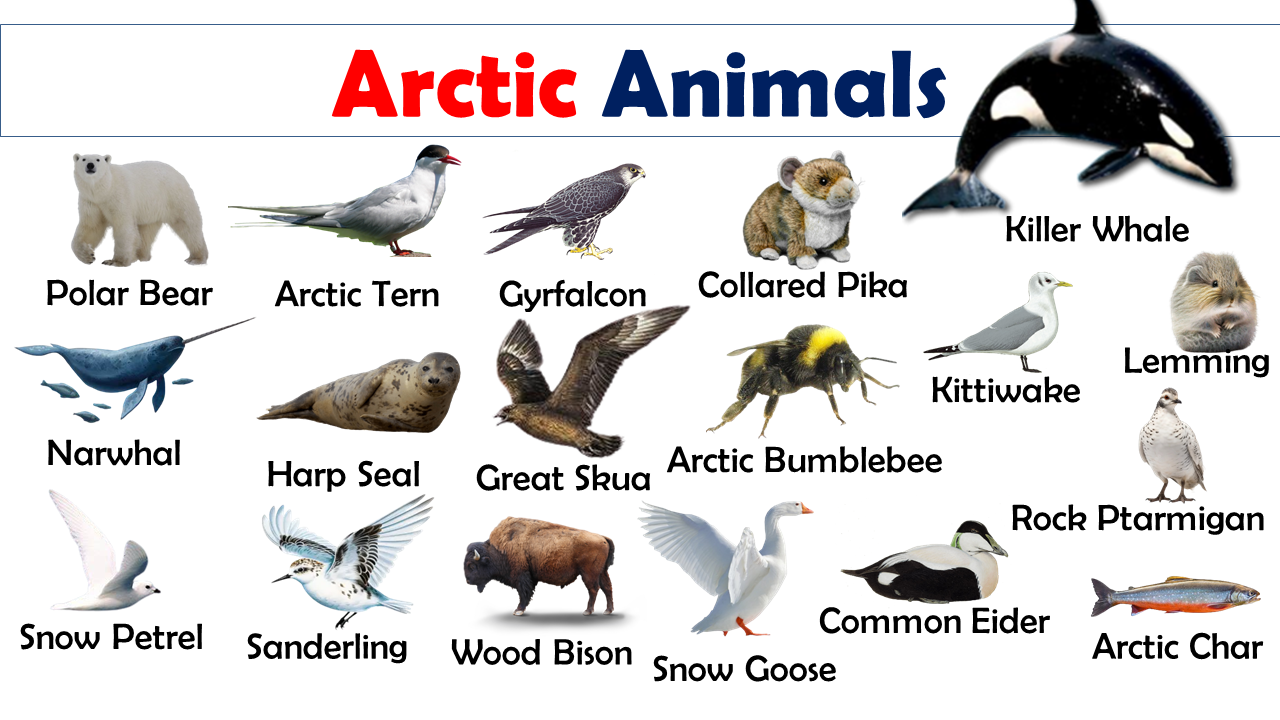The Arctic is a snowy and icy place near the top of the world, and it is home to some amazing animals that are adapted to its cold climate. In this blog post, we will explore creatures like the majestic polar bear, the playful seal, and the hard-working Arctic hare. These animals have special features that help them survive in the Arctic’s extreme conditions. You’ll learn new English words to describe these animals and their fascinating environment. Let’s journey into the world of Arctic animals!
What are Arctic Animals?
The Arctic region, encompassing the Arctic Ocean, parts of northern Alaska, Canada, Greenland, and northern Scandinavia, hosts a unique collection of wildlife adapted to its extreme conditions. These animals are specialized for survival in the frigid climate, with adaptations such as thick insulating layers of fat and fur, and seasonal behaviors to cope with long winters and short summers.
List of Arctic Animals
- Arctic Fox
- Polar Bear
- Narwhal
- Walrus
- Arctic Hare
- Snowy Owl
- Musk Ox
- Caribou (Reindeer)
- Beluga Whale
- Arctic Wolf
- Harp Seal
- Bowhead Whale
- Arctic Ground Squirrel
- Puffin
- Ringed Seal
- Snow Goose
- Greenland Shark
- Ivory Gull
- Svalbard Reindeer
- Arctic Char
- Arctic Tern
- Brunnich’s Guillemot
- King Eider
- Lapland Longspur
- Little Auk
- Northern Fulmar
- Ptarmigan
- Red-throated Loon
- Thick-billed Murre
- Willow Ptarmigan
- Aleutian Tern
- Bearded Seal
- Blue Whale
- Dall’s Porpoise
- Fin Whale
- Gray Whale
- Gyrfalcon
- Hooded Seal
- Kittiwake
- Lemming
- Minke Whale
- Northern Collared Lemming
- Orca (Killer Whale)
- Ross’s Gull
- Sanderling
- Siberian Tundra Reindeer
- Spectacled Eider
- Stellar’s Sea Eagle
- Stoat
- Tundra Swan
- White Whale
- Wood Bison
- Common Eider
- Ermine
- Humpback Whale
- Killer Whale
- Mountain Hare
- Ribbon Seal
- Rock Ptarmigan
- Sabine’s Gull
- Snow Petrel
- Steller Sea Lion
- Yellow-billed Loon
- Arctic Bumblebee
- Collared Pika
- Great Skua
- Greenland Halibut
- Iceland Gull
- Northern Wheatear
- Peregrine Falcon
Explore More Animal Vocab:

Arctic Animals Vocabulary and Their Facts
1. Arctic Fox
The Arctic Fox is well-adapted to survive frigid Arctic temperatures. It changes color with the seasons for camouflage: white in winter to blend with the snow, and brown in summer. This small omnivore feeds on anything from lemmings to berries, playing a crucial role in the Arctic food chain.
2. Polar Bear
The largest terrestrial carnivore, the Polar Bear is an iconic symbol of the Arctic. Its thick fur and layer of fat provide insulation, while its large paws enable it to swim long distances in search of seals, its primary food source. Polar bears are directly impacted by climate change, which threatens their sea ice habitat.
3. Narwhal
Often called the “unicorn of the sea,” Narwhals are notable for their long, spiraled tusk, which is actually an elongated tooth. They inhabit Arctic waters and feed on fish, shrimp, and squid. Narwhals are social animals, often found in large pods.
4. Walrus
The Walrus is distinguished by its large tusks and whiskers. These marine mammals use their tusks to pull themselves onto ice and to fight. Walruses primarily feed on benthic bivalve mollusks, using their sensitive whiskers to detect shellfish on the murky ocean floor.
5. Arctic Hare
The Arctic Hare survives in extreme cold with its thick fur and ability to dig shelters in the snow. It has a diet of woody plants and mosses. Its large hind legs and fast running speed help it escape from predators like the Arctic fox.
6. Snowy Owl
The Snowy Owl is adapted to life in the Arctic with its white plumage providing camouflage against the snow. Unlike most owls, it is diurnal, meaning it hunts during the day. Its diet includes lemmings, Arctic foxes, and fish.
7. Musk Ox
Musk Oxen are known for their thick coats and strong herd behavior. Their underwool, called qiviut, is extremely warm and shed in the summer. They graze on Arctic grasses and use group formations to protect themselves from wolves and other predators.
8. Caribou (Reindeer)
Caribou are vital to Arctic ecosystems and Indigenous cultures. They undertake long migrations to access seasonal feeding grounds. Their large hooves act like snowshoes, helping them traverse soft snow and dig for food beneath it.
9. Beluga Whale
Known for their distinct white color and vocal behavior, Beluga Whales are social creatures, living in pods of up to several dozen. They communicate with a variety of clicks, whistles, and clangs, and can even mimic other sounds.
10. Arctic Wolf
The Arctic Wolf, a subspecies of the gray wolf, has white fur that allows it to blend into its snowy environment. It preys mainly on musk oxen and caribou, often using pack cooperation to hunt effectively in the challenging Arctic conditions.
11. Harp Seal
Harp Seals are named for the harp-shaped markings on the backs of adults. They live in icy waters of the North Atlantic and Arctic Oceans. Their pups, known for their fluffy white fur, are born on the ice and are vulnerable to predators.
12. Bowhead Whale
Bowhead Whales are known for their massive bow-shaped head and thick blubber, which can be up to 1.5 feet thick, helping them to break through Arctic ice. They are one of the longest-living mammals, with some individuals living over 200 years.
13. Arctic Ground Squirrel
The Arctic Ground Squirrel is the only Arctic mammal that truly hibernates. It burrows underground and can lower its body temperature to just above freezing during hibernation. This squirrel’s diet includes seeds, leaves, and small invertebrates.
14. Puffin
Puffins are colorful seabirds that breed in colonies on the coasts of the North Atlantic and Arctic. Known for their striking beaks, they dive underwater to catch fish. Puffins are agile in the air and water but awkward on land.
15. Ringed Seal
The Ringed Seal is the smallest and most common seal in the Arctic, named after the dark rings on its back. They are primary prey for polar bears and use sharp claws to maintain breathing holes in the ice.
16. Snow Goose
Snow Geese breed in the Arctic tundra and migrate south in large, noisy flocks. Their white plumage helps them blend into the snowy landscape, with some birds displaying a dark color phase known as “blue.”
17. Greenland Shark
The Greenland Shark is one of the Arctic’s most elusive species, known for its slow swimming and longevity; these sharks can live for hundreds of years. They are apex predators and scavengers, often found in deep Arctic waters.
18. Ivory Gull
The Ivory Gull primarily inhabits the high Arctic, feeding on fish and scavenging on the leftovers from polar bear kills. Its completely white plumage allows it to blend in with the icy surroundings, helping it avoid predators.
19. Svalbard Reindeer
Unique to the Svalbard archipelago, these reindeer are smaller than other types and have thicker fur. They feed on lichens, grasses, and leaves, adapting their metabolism to the harsh Arctic winter.
20. Arctic Char
Arctic Char is a cold-water fish found in Arctic and sub-Arctic waters. It is similar to salmon but spends its entire life in freshwater or close to its Arctic coastal birthplace. It’s a key species for local fishing economies.
21. Arctic Tern
The Arctic Tern is famous for having the longest migration of any animal, traveling from its Arctic breeding grounds to the Antarctic each year. It feeds primarily on fish and small marine invertebrates.
22. Brunnich’s Guillemot
Brunnich’s Guillemot, also known as the Thick-billed Murre, breeds on steep Arctic cliffs and dives deep to catch fish. They are social birds, often seen in large flocks on the water.
23. King Eider
The King Eider is a large sea duck that breeds along Arctic coasts. The males are brightly colored, which contrasts sharply with the females’ camouflaged brown plumage. They dive to feed on mollusks and crustaceans.
24. Lapland Longspur
The Lapland Longspur is a small bird that breeds in the Arctic tundra. It has a melodious song and feeds on insects and seeds. The bird’s plumage blends well with the tundra landscape, providing protection against predators.
25. Little Auk
The Little Auk, or Dovekie, is a small seabird that breeds in large colonies on Arctic cliffs. It feeds on plankton and small fish, captured by diving underwater. Its black and white plumage aids in camouflage from aerial and aquatic predators.
26. Northern Fulmar
The Northern Fulmar is a seabird that resembles a gull but is more closely related to albatrosses. It is an excellent glider, feeding on fish, squid, and plankton at the ocean’s surface.
27. Ptarmigan
The Ptarmigan, a game bird, changes its plumage from mottled brown in summer to pure white in winter. It feeds on twigs and leaves, and its feathered feet act like snowshoes.
28. Red-throated Loon
The Red-throated Loon is known for its distinctive red throat patch during breeding season. It dives from the surface to catch fish, and its haunting calls are a characteristic sound of the Arctic.
29. Thick-billed Murre
The Thick-billed Murre lives on the open sea, only coming ashore to breed on steep cliffs. It dives to great depths to feed on fish and invertebrates, using its wings to swim underwater.
30. Willow Ptarmigan
The Willow Ptarmigan is Alaska’s state bird, with plumage that changes color seasonally for camouflage. It has feathered feet that help it walk on snow, and it feeds on buds and leaves of willow and birch.
